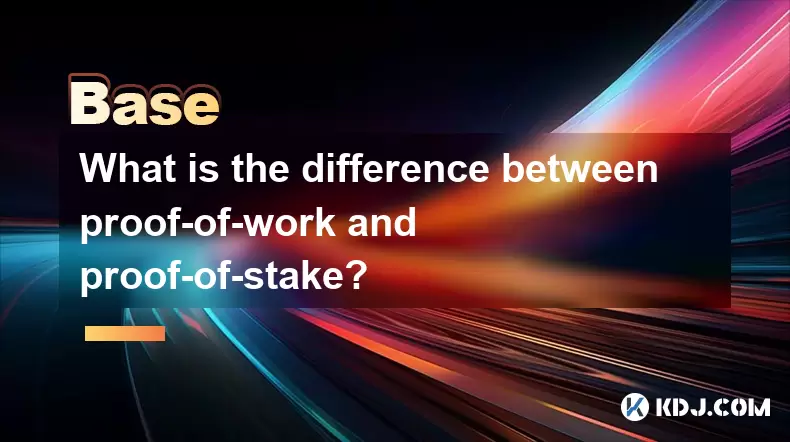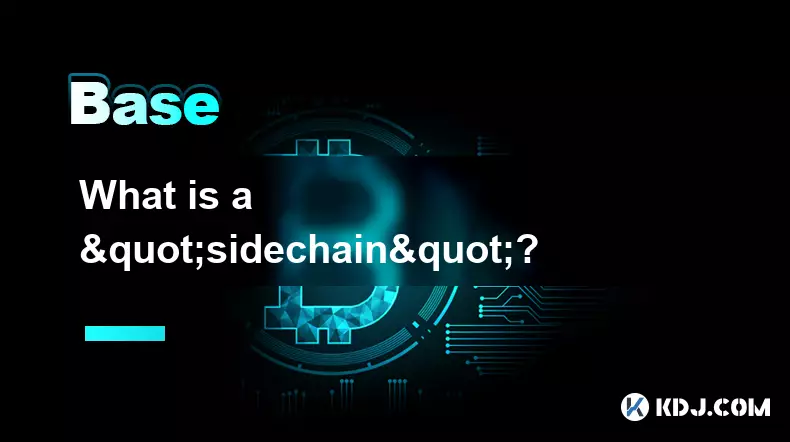-
 bitcoin
bitcoin $114684.631706 USD
-0.87% -
 ethereum
ethereum $4228.677447 USD
1.58% -
 bnb
bnb $1294.880693 USD
-1.16% -
 tether
tether $1.000819 USD
-0.02% -
 xrp
xrp $2.605138 USD
2.79% -
 solana
solana $209.908690 USD
5.89% -
 usd-coin
usd-coin $0.999903 USD
-0.03% -
 dogecoin
dogecoin $0.213423 USD
2.93% -
 tron
tron $0.322721 USD
-0.10% -
 cardano
cardano $0.727247 USD
3.66% -
 hyperliquid
hyperliquid $42.339456 USD
6.05% -
 chainlink
chainlink $19.910811 USD
5.16% -
 ethena-usde
ethena-usde $1.000557 USD
0.00% -
 stellar
stellar $0.349734 USD
2.69% -
 bitcoin-cash
bitcoin-cash $543.848687 USD
-0.21%
What is the difference between proof-of-work and proof-of-stake?
Proof-of-work relies on energy-intensive mining, while proof-of-stake uses economic stakes to secure the network, offering greater energy efficiency and lower barriers to entry.
Aug 13, 2025 at 11:35 am

Understanding the Core Mechanisms of Consensus
In blockchain networks, achieving agreement among distributed participants is essential to validate transactions and maintain ledger integrity. The two dominant methods used to achieve this are proof-of-work (PoW) and proof-of-stake (PoS). Both serve the same fundamental purpose: to prevent double-spending and ensure that only valid blocks are added to the blockchain. However, they differ significantly in how they select block validators and secure the network. PoW relies on computational power, while PoS depends on the economic stake held by participants.
How Proof-of-Work Operates
Proof-of-work requires miners to solve complex cryptographic puzzles using substantial computational resources. The first miner to solve the puzzle broadcasts the solution to the network for verification. Once confirmed, the new block is added to the chain, and the miner receives a block reward. This process is highly competitive and energy-intensive. The difficulty of the puzzle adjusts periodically to maintain consistent block times, regardless of how many miners are active.
- Miners use specialized hardware like ASICs (Application-Specific Integrated Circuits) to maximize hash rate.
- Electricity consumption is a major operational cost, leading to concerns about environmental impact.
- Security is derived from the high cost of acquiring and operating mining equipment.
- The probability of mining a block is directly proportional to the miner’s share of the total network hash power.
Because solving these puzzles requires real-world resources, attacking the network would demand an unrealistic amount of energy and capital, making PoW secure against most forms of manipulation.
How Proof-of-Stake Functions Differently
Proof-of-stake replaces computational work with economic commitment. Instead of miners, PoS uses validators who lock up a certain amount of cryptocurrency as a stake. The protocol selects validators to propose and attest to new blocks based on factors like the size of their stake and the duration it has been held. Some systems also introduce randomness to prevent centralization.
- Validators must deposit a minimum amount of coins—such as 32 ETH in Ethereum’s PoS system—to activate their validation rights.
- If a validator attempts to cheat or validate fraudulent transactions, part or all of their stake can be slashed.
- Rewards are distributed in newly minted coins and transaction fees, proportional to the validator’s honest participation.
- Energy consumption is drastically lower because no intensive calculations are required.
This shift reduces barriers related to hardware and electricity, enabling broader participation while maintaining network security through financial incentives.
Comparing Security Models and Attack Vectors
The security assumptions in PoW and PoS are fundamentally different. In PoW, security comes from the cost of acquiring and running mining hardware. An attacker would need to control more than 50% of the network’s total hash power to manipulate the blockchain—a scenario known as a 51% attack. Executing such an attack is prohibitively expensive and detectable due to sudden changes in hash rate distribution.
In contrast, PoS secures the network by making attacks financially irrational. To launch a 51% attack in a PoS system, an adversary must acquire over half of the staked tokens. This would not only require immense capital but also trigger economic countermeasures:
- The market value of the token would likely surge as the attacker buys large quantities, increasing the cost of the attack.
- Honest validators can coordinate to fork the chain and blacklist the malicious actor, preserving the legitimate version of the ledger.
- Slashing mechanisms automatically penalize dishonest behavior, reducing the attacker’s stake.
PoS thus ties security directly to the native cryptocurrency’s value and the economic rationality of participants.
Energy Efficiency and Environmental Impact
One of the most discussed differences between PoW and PoS is their environmental footprint. PoW networks like Bitcoin consume vast amounts of electricity, often comparable to the annual usage of small countries. This energy is spent continuously on hashing operations, even when the network is idle.
PoS eliminates the need for constant computation. Validators run software on ordinary computers, consuming minimal power. For example, after Ethereum transitioned to PoS in 2022, its energy consumption dropped by over 99.9%. This dramatic reduction makes PoS a more sustainable option, especially as regulatory scrutiny on carbon emissions increases.
- PoW’s energy use is a feature, not a bug—it ensures security through real-world cost.
- PoS achieves security through economic penalties, reducing reliance on physical resources.
- Critics argue PoW’s energy expenditure supports grid stability in some regions by utilizing excess power.
Despite differing views on energy use, the efficiency of PoS is undisputed from a technical standpoint.
Decentralization and Accessibility Considerations
Decentralization is a core principle in blockchain design, and both models approach it differently. PoW allows anyone with hardware to participate, but over time, mining has become centralized among large pools and organizations that can afford industrial-scale operations. Geographic concentration in regions with cheap electricity further limits decentralization.
PoS lowers entry barriers in terms of energy and equipment but introduces financial barriers. Owning a significant stake is necessary to be selected as a validator. To address this, many PoS networks support staking pools, where users combine their tokens to meet the minimum requirement and share rewards proportionally.
- Solo staking offers full control but requires technical setup.
- Pool staking reduces individual responsibility but involves service fees.
- Some platforms offer liquid staking derivatives (e.g., stETH), allowing users to trade staked assets while earning rewards.
While PoS promotes energy-efficient participation, concerns remain about wealth concentration influencing block validation rights.
Frequently Asked Questions
Can a PoW blockchain switch to PoS?Yes, a blockchain can transition from PoW to PoS through a hard fork or protocol upgrade. Ethereum completed this transition in September 2022 during 'The Merge,' switching its consensus mechanism while preserving account balances and transaction history. Such upgrades require extensive testing, community consensus, and coordination among node operators and developers.
What happens if a PoS validator goes offline?If a validator disconnects temporarily, they may miss out on rewards. Prolonged downtime can result in penalties known as 'slashing' or partial stake reduction, depending on the network rules. Most systems allow validators to delegate uptime monitoring to third-party services to avoid accidental penalties.
Is PoW obsolete now that PoS exists?No, PoW is not obsolete. Bitcoin and several other major cryptocurrencies continue to use PoW due to its proven security and resistance to certain types of manipulation. Some developers and users prefer PoW for its simplicity and long-term track record, despite its energy costs.
Do PoS networks still have mining?No, PoS networks do not involve mining in the traditional sense. There is no computational puzzle-solving. Instead, new blocks are created through a process called 'forging' or 'minting', where validators are chosen to create blocks based on their stake and other protocol-specific criteria.
Disclaimer:info@kdj.com
The information provided is not trading advice. kdj.com does not assume any responsibility for any investments made based on the information provided in this article. Cryptocurrencies are highly volatile and it is highly recommended that you invest with caution after thorough research!
If you believe that the content used on this website infringes your copyright, please contact us immediately (info@kdj.com) and we will delete it promptly.
- XRP Price Prediction: Weekend Rollercoaster or Rally?
- 2025-10-12 08:45:16
- Bittensor (TAO): Super Bullish Signals Point to Potential 2x Rally
- 2025-10-11 10:25:12
- Silver Price Correction: Navigating the Dip & Identifying Key SEO Keywords
- 2025-10-11 10:25:12
- Decoding Crypto Trends: Bittensor's Bull Run, Cardano's Dip, and LivLive's Presale Buzz in 'Uptober 2025'
- 2025-10-12 08:45:16
- MoonBull: The Crypto Meme Coin Promising 1000x Gains?
- 2025-10-11 10:30:01
- Crypto Payroll Revolution: Stablecoins, Altcoins, and the Future of Salary Payments
- 2025-10-11 10:30:01
Related knowledge

What does it mean for code to be "open source" in crypto?
Oct 12,2025 at 01:54pm
Understanding Open Source in the Cryptocurrency Ecosystem1. In the context of cryptocurrency, open source refers to software whose code is publicly ac...

What is the purpose of a "testnet"?
Oct 12,2025 at 09:01am
Understanding the Role of Testnets in Blockchain Development1. A testnet serves as a parallel version of a blockchain network, designed specifically f...

How to avoid phishing scams in crypto?
Oct 13,2025 at 06:18pm
Understanding Common Crypto Phishing Tactics1. Cybercriminals frequently use fake websites that mirror legitimate crypto exchanges or wallet platforms...

What is the difference between single-collateral and multi-collateral Dai?
Oct 12,2025 at 05:18pm
Understanding Single-Collateral Dai1. Single-Collateral Dai (SCD) was the original version of the Dai stablecoin launched by MakerDAO in 2017. It allo...

What is a "sidechain"?
Oct 13,2025 at 02:36pm
Understanding the Concept of Sidechains1. A sidechain is a blockchain that operates independently but is connected to another blockchain, known as the...

What is "EIP-1559" and how did it change Ethereum?
Oct 12,2025 at 03:00am
Understanding EIP-1559 and Its Core Mechanism1. EIP-1559 is a protocol upgrade introduced to the Ethereum blockchain as part of the London hard fork i...

What does it mean for code to be "open source" in crypto?
Oct 12,2025 at 01:54pm
Understanding Open Source in the Cryptocurrency Ecosystem1. In the context of cryptocurrency, open source refers to software whose code is publicly ac...

What is the purpose of a "testnet"?
Oct 12,2025 at 09:01am
Understanding the Role of Testnets in Blockchain Development1. A testnet serves as a parallel version of a blockchain network, designed specifically f...

How to avoid phishing scams in crypto?
Oct 13,2025 at 06:18pm
Understanding Common Crypto Phishing Tactics1. Cybercriminals frequently use fake websites that mirror legitimate crypto exchanges or wallet platforms...

What is the difference between single-collateral and multi-collateral Dai?
Oct 12,2025 at 05:18pm
Understanding Single-Collateral Dai1. Single-Collateral Dai (SCD) was the original version of the Dai stablecoin launched by MakerDAO in 2017. It allo...

What is a "sidechain"?
Oct 13,2025 at 02:36pm
Understanding the Concept of Sidechains1. A sidechain is a blockchain that operates independently but is connected to another blockchain, known as the...

What is "EIP-1559" and how did it change Ethereum?
Oct 12,2025 at 03:00am
Understanding EIP-1559 and Its Core Mechanism1. EIP-1559 is a protocol upgrade introduced to the Ethereum blockchain as part of the London hard fork i...
See all articles










































































